If you have ever visited Turkey or are a fan of Turkish food, you know our version of a bagel, Turkish Simit bread. It is one of those iconic Turkish recipes, right up there with Turkish Coffee, Borek, and Turkish Bulgur Pilaf.
Usually served with feta cheese, olives, and Turkish tea or ayran (aka Turkish Yogurt Drink), simit has been a breakfast staple in every Turkish household for centuries. Sadly, for those of us living outside of Turkey, it is not easy to find (unless you are living in a town with a great Turkish restaurant.) The good news is that making simit at home is easy with my foolproof method.
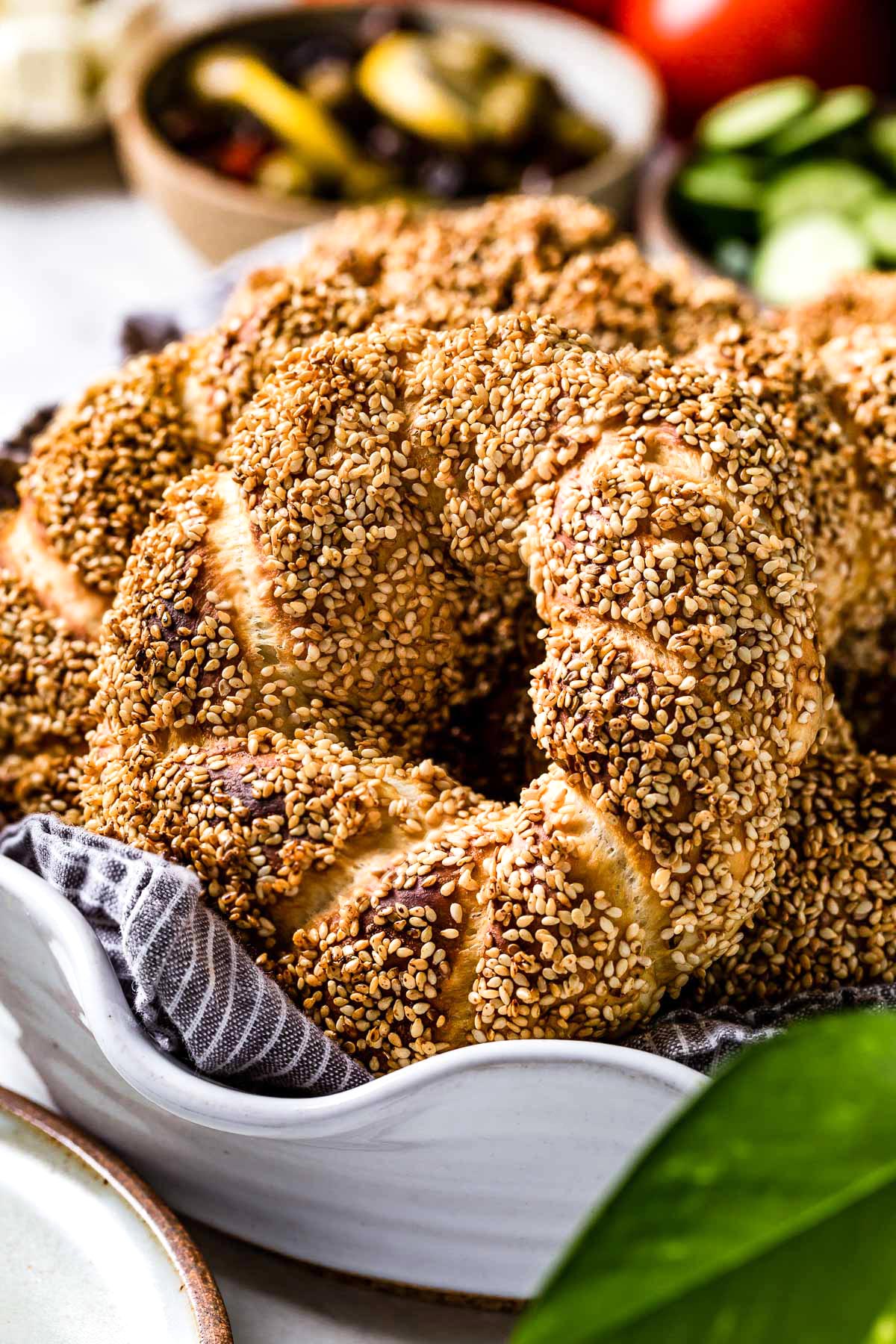
What Is Simit?
Simit also referred to as gevrek or gjevrek, is a sesame-bathed, circular Turkish bread. It is similar to an American bagel in how it looks but crustier on the outside and softer on the inside.
Because it is mainly served for breakfast, I’ve heard some people in the US refer to it as “Turkish Bagel” or “Turkish Pretzel.”
Traditionally sold by street vendors on the streets of Turkey for no more than $0.50, it is usually made by twisting simit dough and dipping it in molasses and toasted sesame seeds before baking it in the oven.
Simit Ingredients:
To make it easier, I will divide the Turkish Sesame Bread ingredients into three parts.
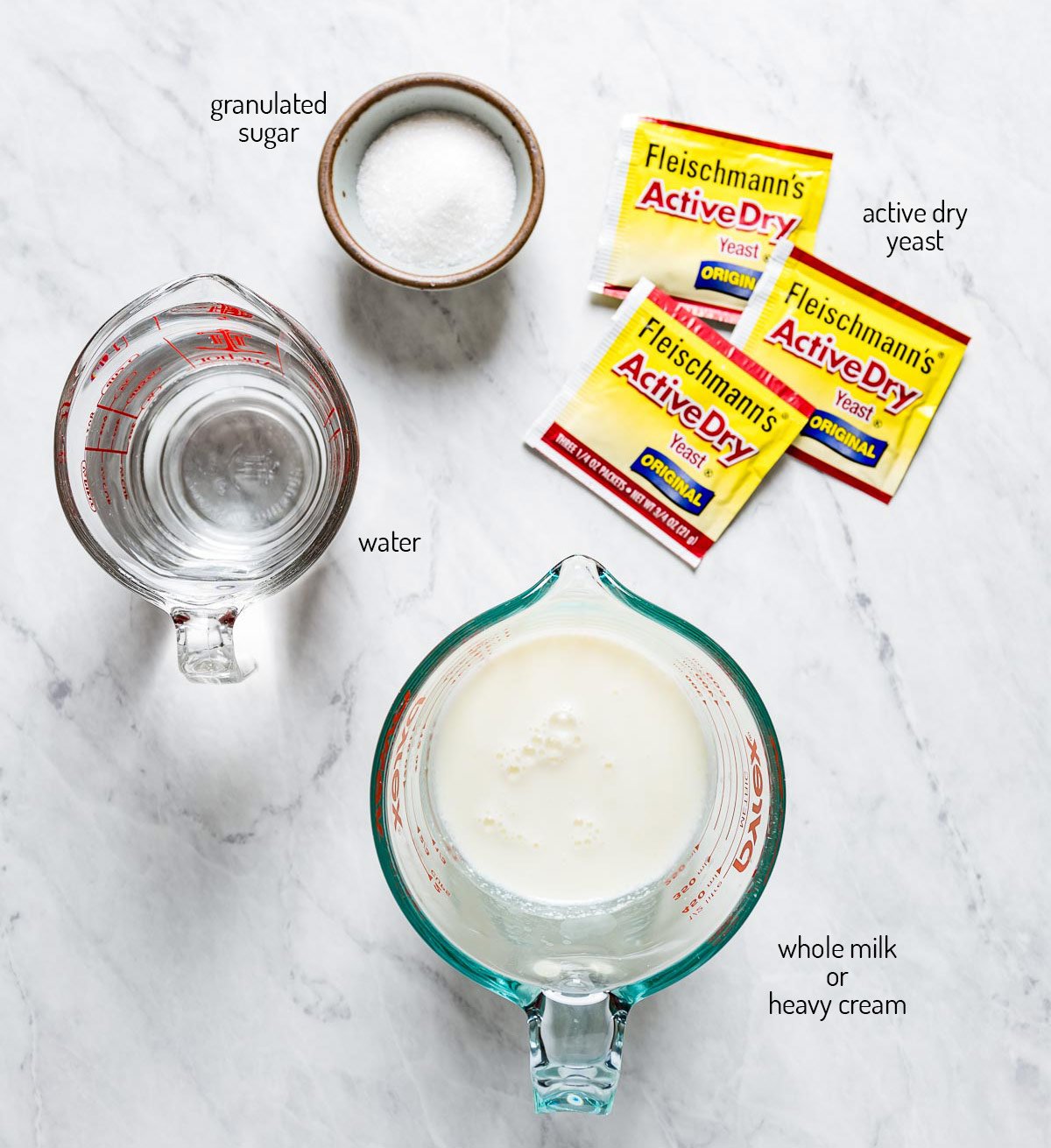
The Yeast & Milk Mixture:
- Water at 110 Fahrenheit degrees (43 Celsius degrees)
- 1 cup whole milk (or heavy cream) at room temperature: You can use milk and heavy cream interchangeably in this recipe. The version of Simit bagel made with heavy cream is richer due to the higher fat content of heavy cream. Still, if you can’t find it, you can substitute it with whole milk. I would not recommend substituting plant-based milk in this recipe.
- 2 tablespoons or 3 (1/4 oz.) packets of active dry yeast (I used Fleischmann’s)
- Granulated sugar
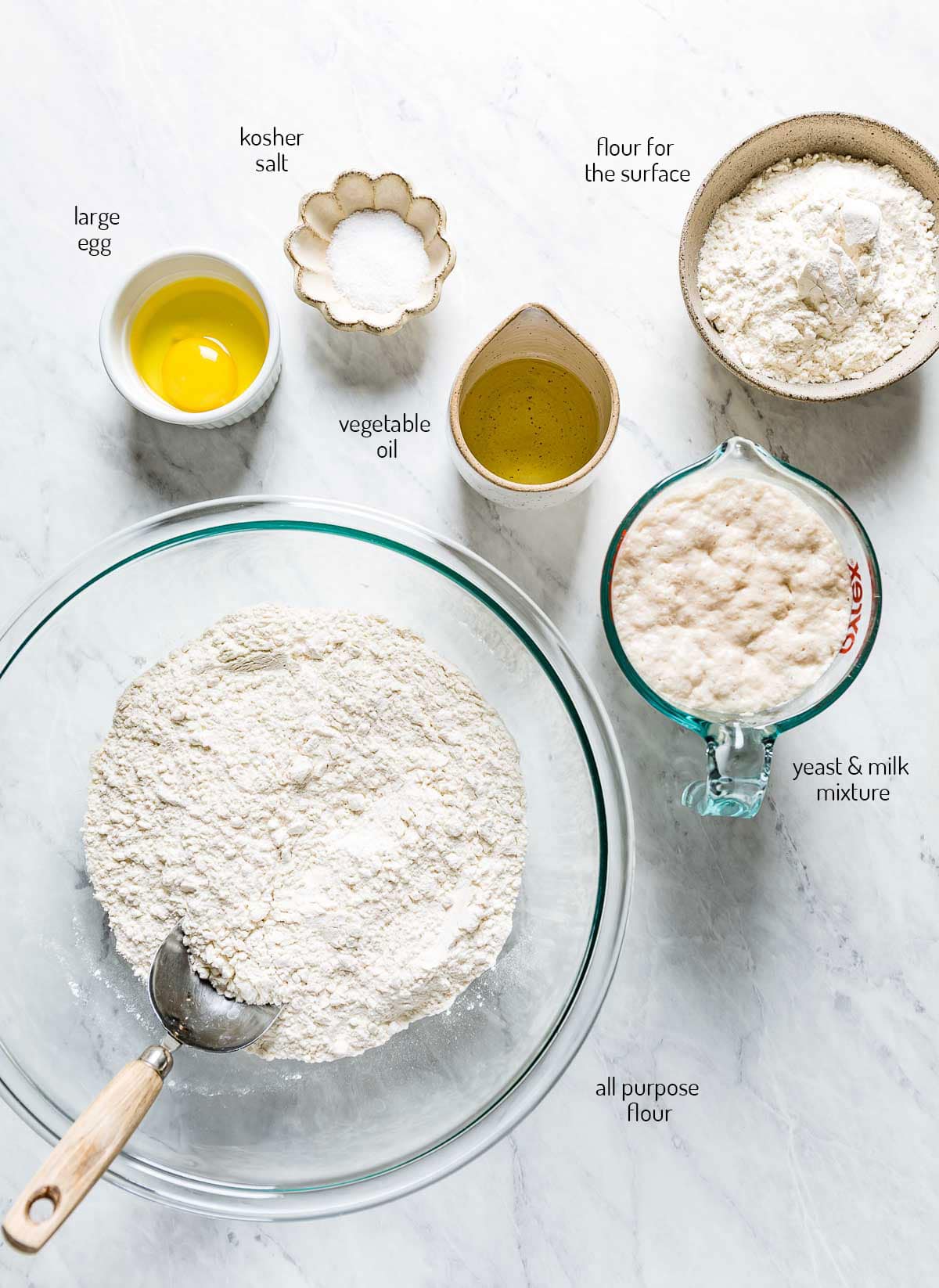
The dough of the ingredients:
- All-purpose flour: I tested this recipe with several all-purpose flour brands, and the results were similar. I personally like King Arthur Flour as it has a higher amount of protein which is ideal for making bread. The recipe below starts with 5 cups, but you will need at least 1 to 1 ½ cups or more flour to use on the surface as you are kneading the simit dough.
- Large egg
- Kosher salt
- Vegetable oil (avocado oil, canola oil, or grapeseed oil would all work.)
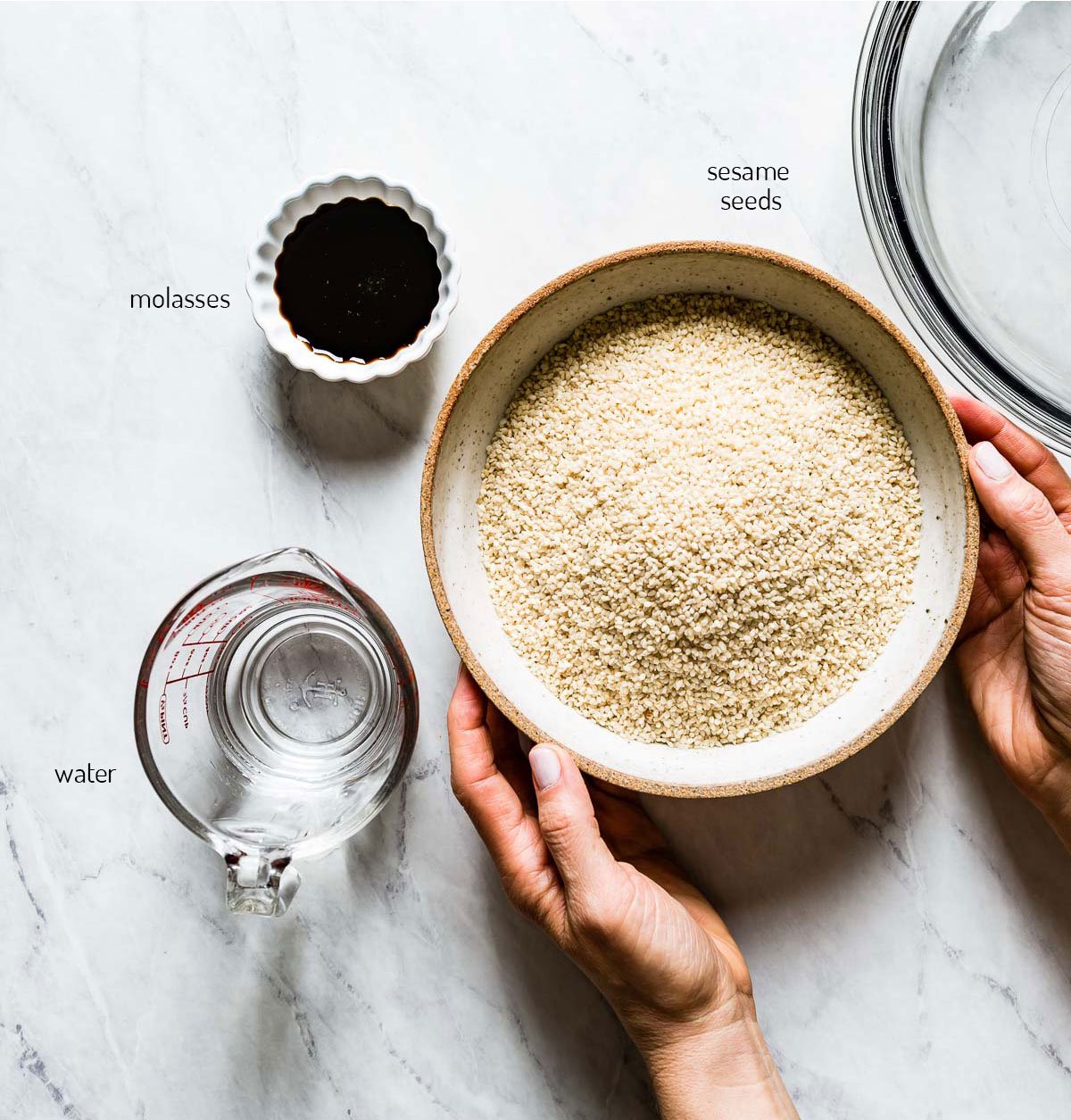
The Sesame Coating
- Molasses (I used Grandma’s Molasses – affiliate link): Alternatively, you can also use pomegranate or grape molasses (this Turkish Molasses is my favorite) if you can get your hands on them, which is traditionally used in Turkey. Molasses coating helps sesame seeds stick to the dough and give the overall bread slight sweetness that its known for.
- White sesame seeds
How To Make Simit?
This Simit bread recipe below makes ten sesame breads. Even though the steps look like a lot, the process of making simit is quite simple.
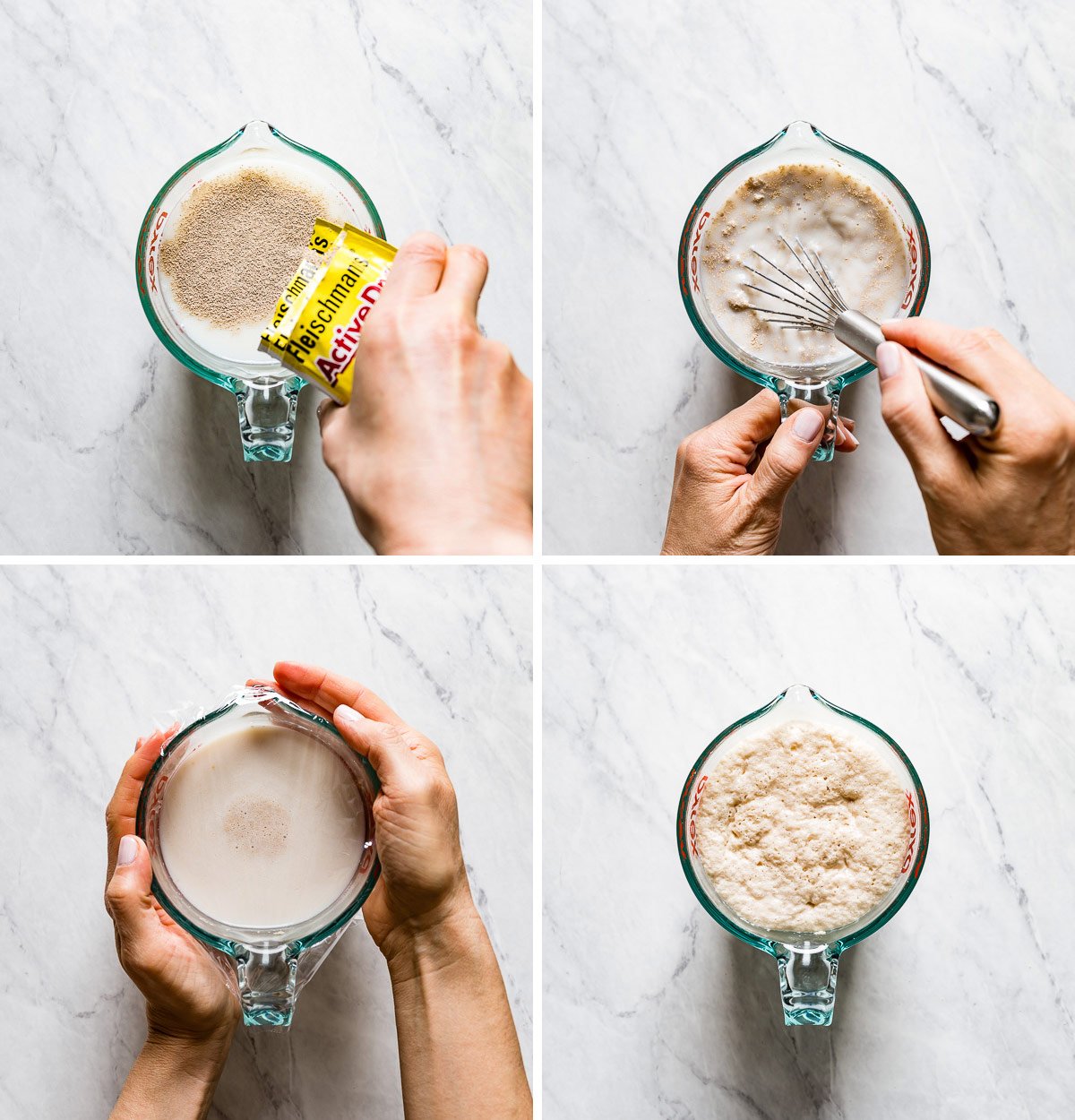
- Activate the yeast: Place water, milk, sugar, and active dry yeast into a measuring cup. Give it a quick whisk, cover it with stretch film, and let it sit on the counter for 10 to 15 minutes or until bubbles form on top.
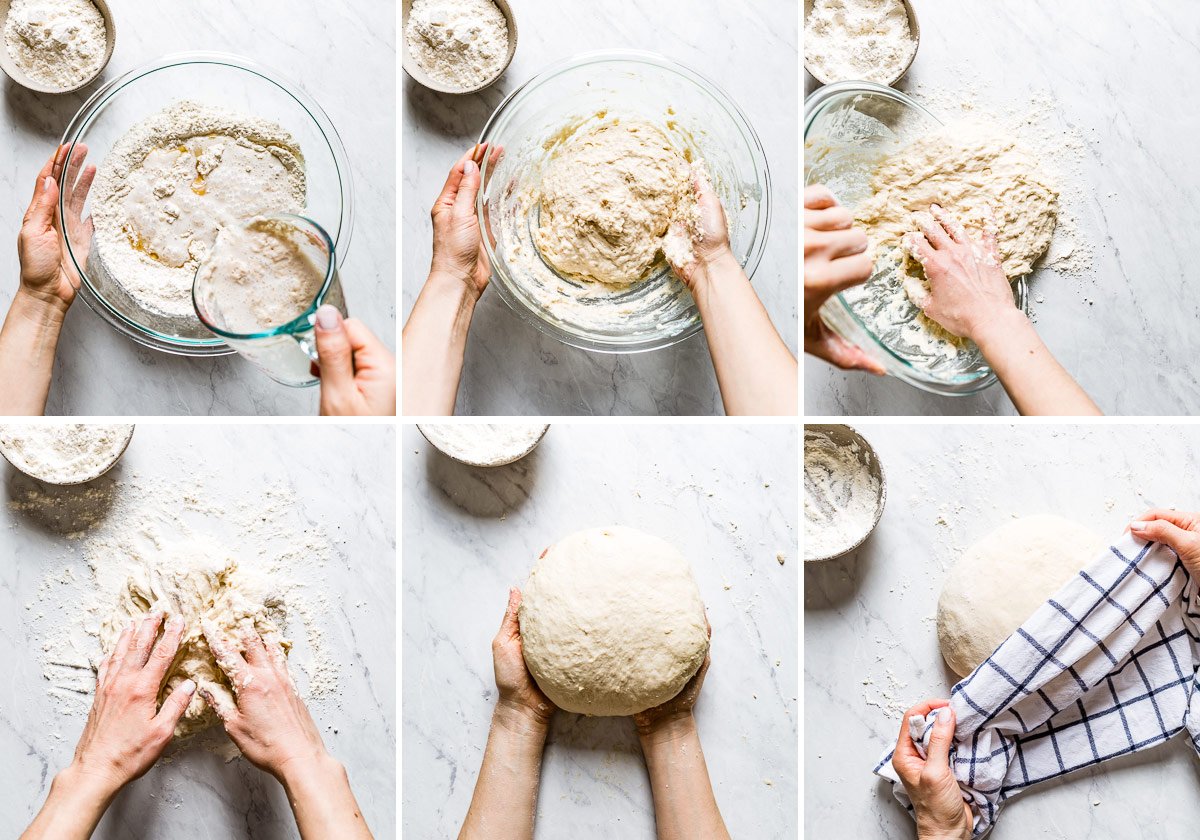
- Make the simit dough: Place 5 cups (700 grams) of all-purpose flour, kosher salt, oil, egg, and now-risen yeast-milk mixture in a large mixing bowl. Start mixing the sesame Turkish bread dough by hand until it comes together. Lightly dust the counter with flour and dump the dough onto the surface. Knead by hand to form a smooth and elastic dough until the dough is not sticking to your fingers. This may take around 15 to 17 minutes. Alternatively, you can do this in a stand mixer. I included the instructions for that in the recipe card below.
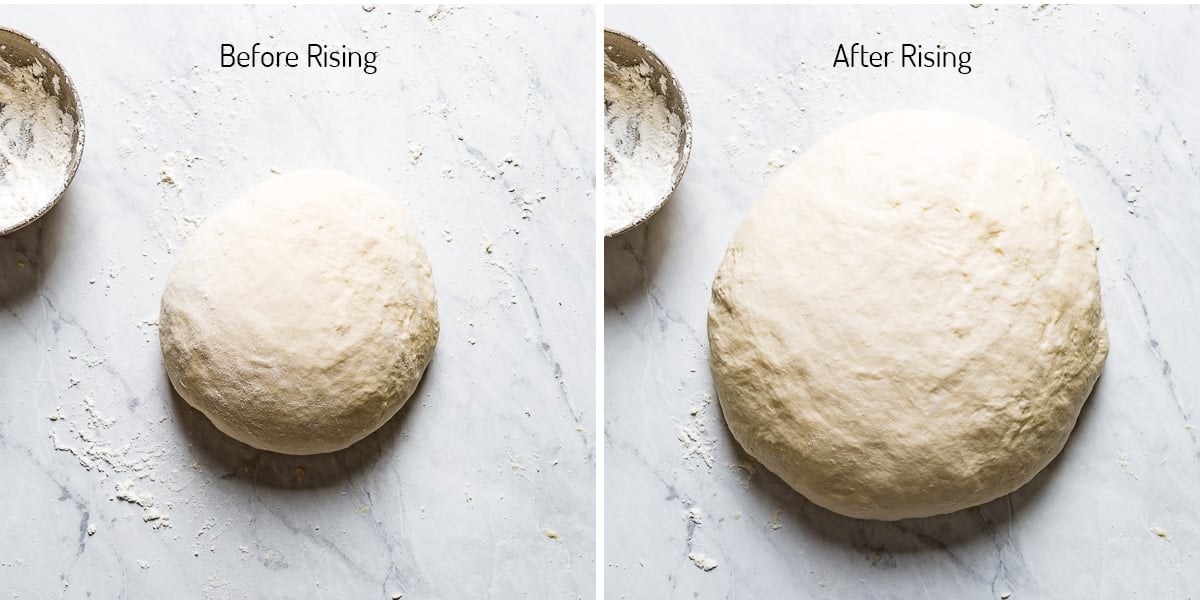
- Let the simit dough rise: Lightly wet a kitchen towel with hot tap water and place it over the dough. Let it sit on the kitchen counter until it doubles in size, 30-45 minutes.

- Toast sesame seeds: While the dough is rising, place sesame seeds in a large non-stick skillet over medium heat, stirring constantly, and toast until they turn golden brown, 20-25 minutes. Transfer to a large shallow plate to cool.
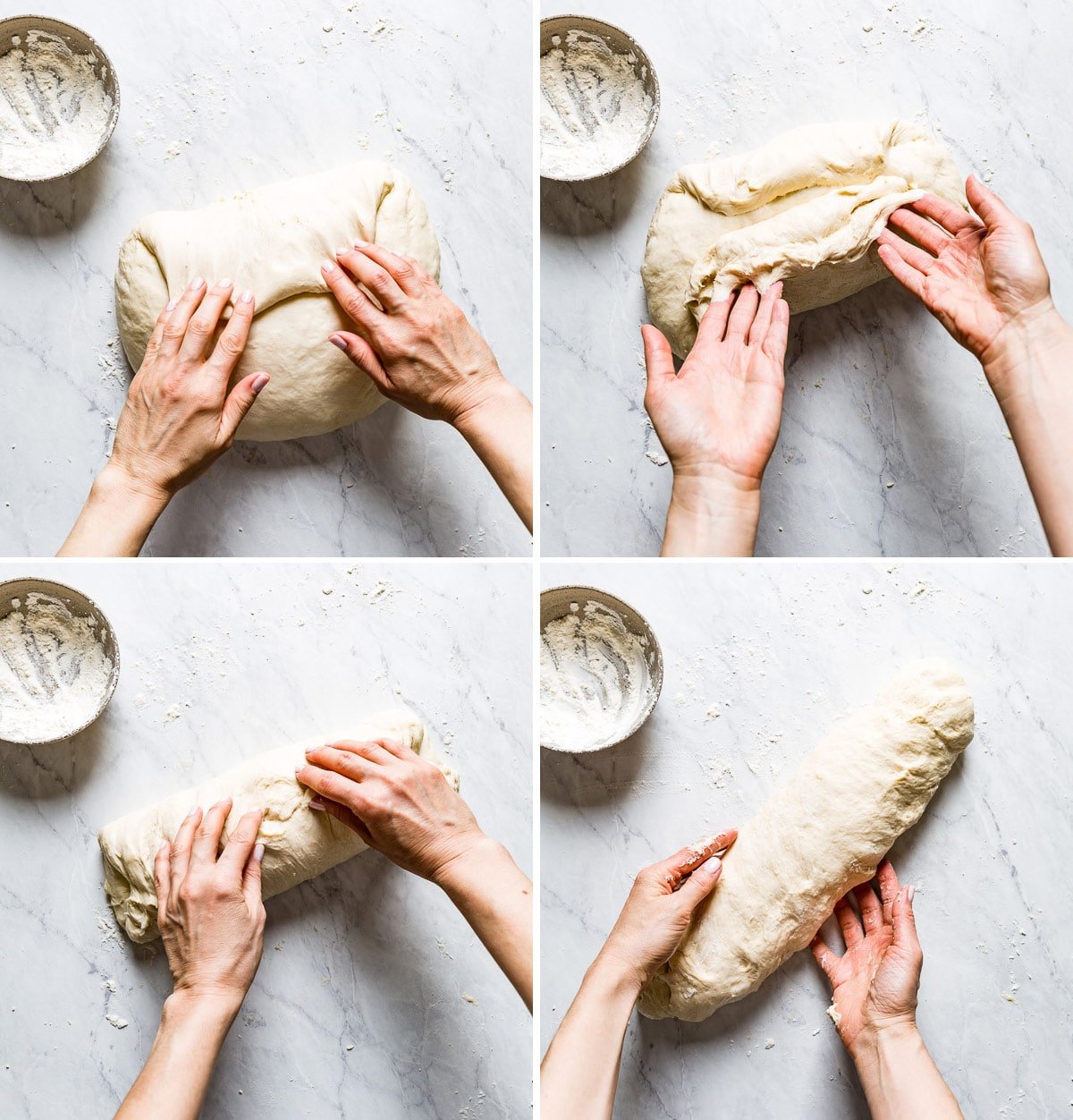
- Turn the dough into a cylinder: Fold the dough from each end onto itself towards the middle, gently pinch, and roll into a cylinder of roughly 20-inches (51 cm.)
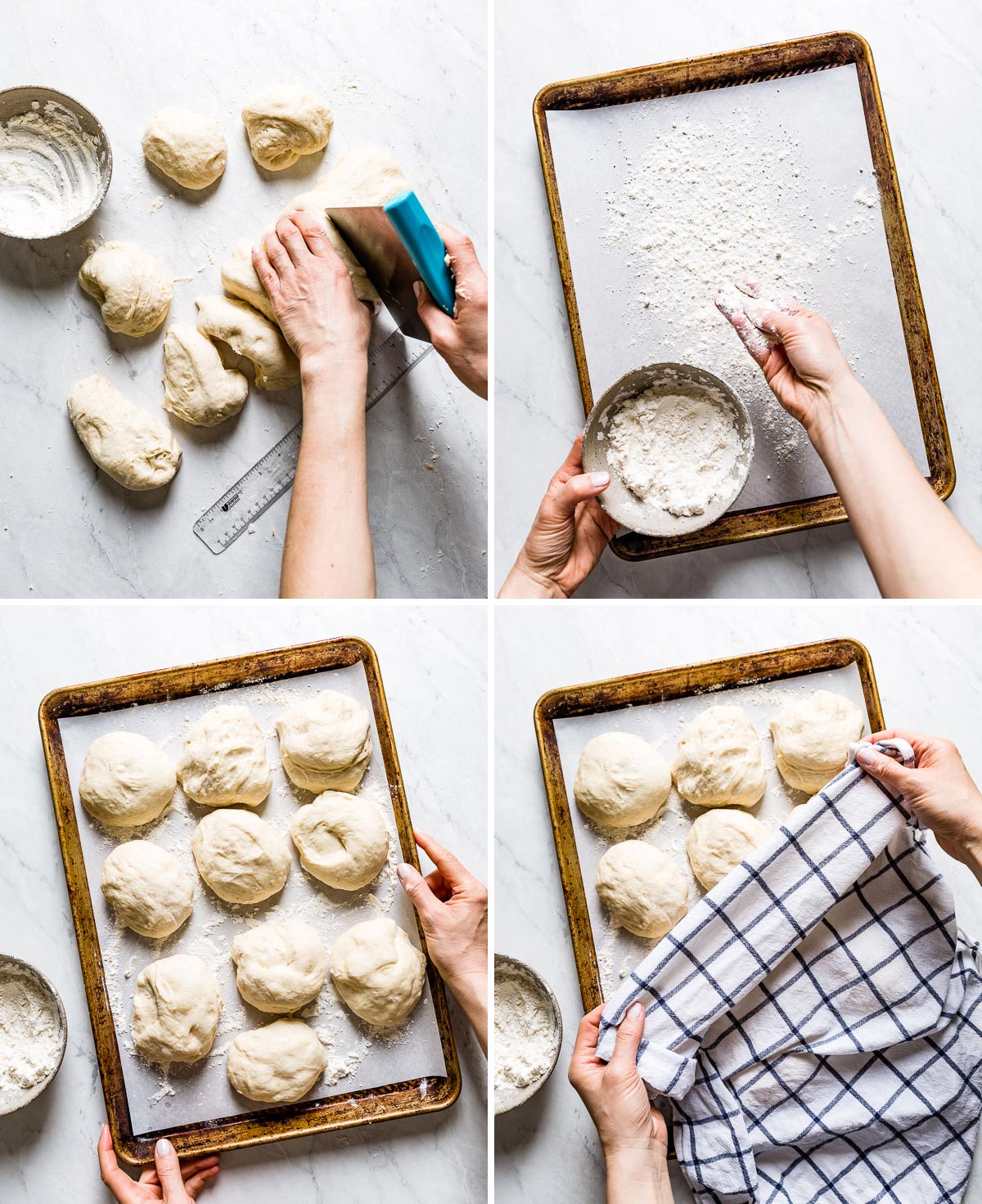
- Divide the now-risen dough: Using a sharp knife or a pastry scraper, divide the dough into 10 equal pieces and transfer onto a sheet pan (lined with parchment paper and sprinkled with flour.) Cover it with a clean kitchen towel (to prevent them from drying as you work on each piece.)
- Preheat the oven to 400 F degrees. Line two baking sheets with parchment paper.
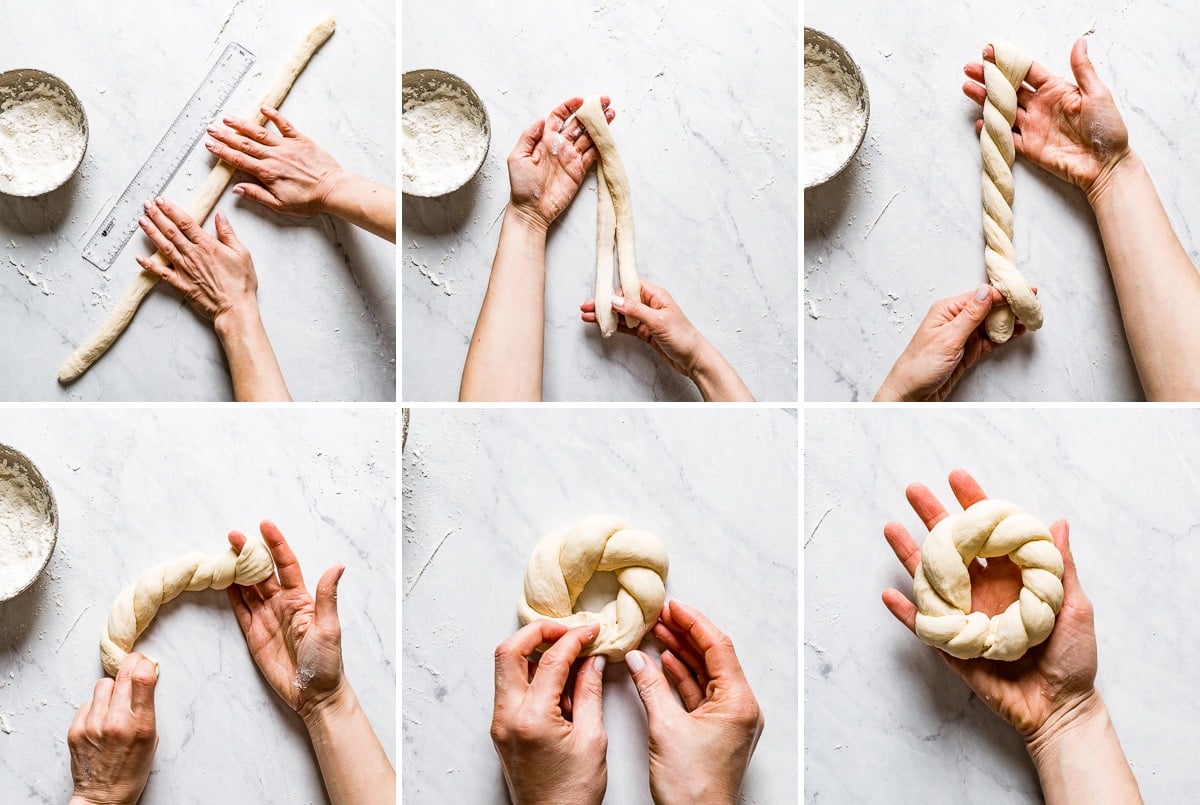
- Shape each simit dough: Roll each dough ball into a roughly 40-inch (102 cm) long strand. Fold the string onto itself using your finger to hold it in the middle. Twist the dough in the opposite direction to form a spiral rope. Roll it into a 5-inch diameter ring and gently pinch the end to seal.

- Let them rest: Transfer the now-shaped dough onto the parchment-lined baking sheet. Repeat the same process for the rest of the dough balls. Let them rest until they rise for 30 minutes. How much they rise depends on the temperature of your kitchen. (You can learn more about this in the tips section below)

- Dip simit into molasses and sesame seeds: Mix together molasses with water in a large shallow plate. Bring in the sesame seeds. First, dip simit into the molasses mixture (on both sides) and then into the sesame seeds making sure that all sides are fully covered with sesame seeds. Transfer the sesame-seeded bread onto a baking sheet and repeat the same process for the rest of the limit. Do not skip this part as sesame seeds add a nutty flavor and crunch texture to simit, which makes this bread so special.
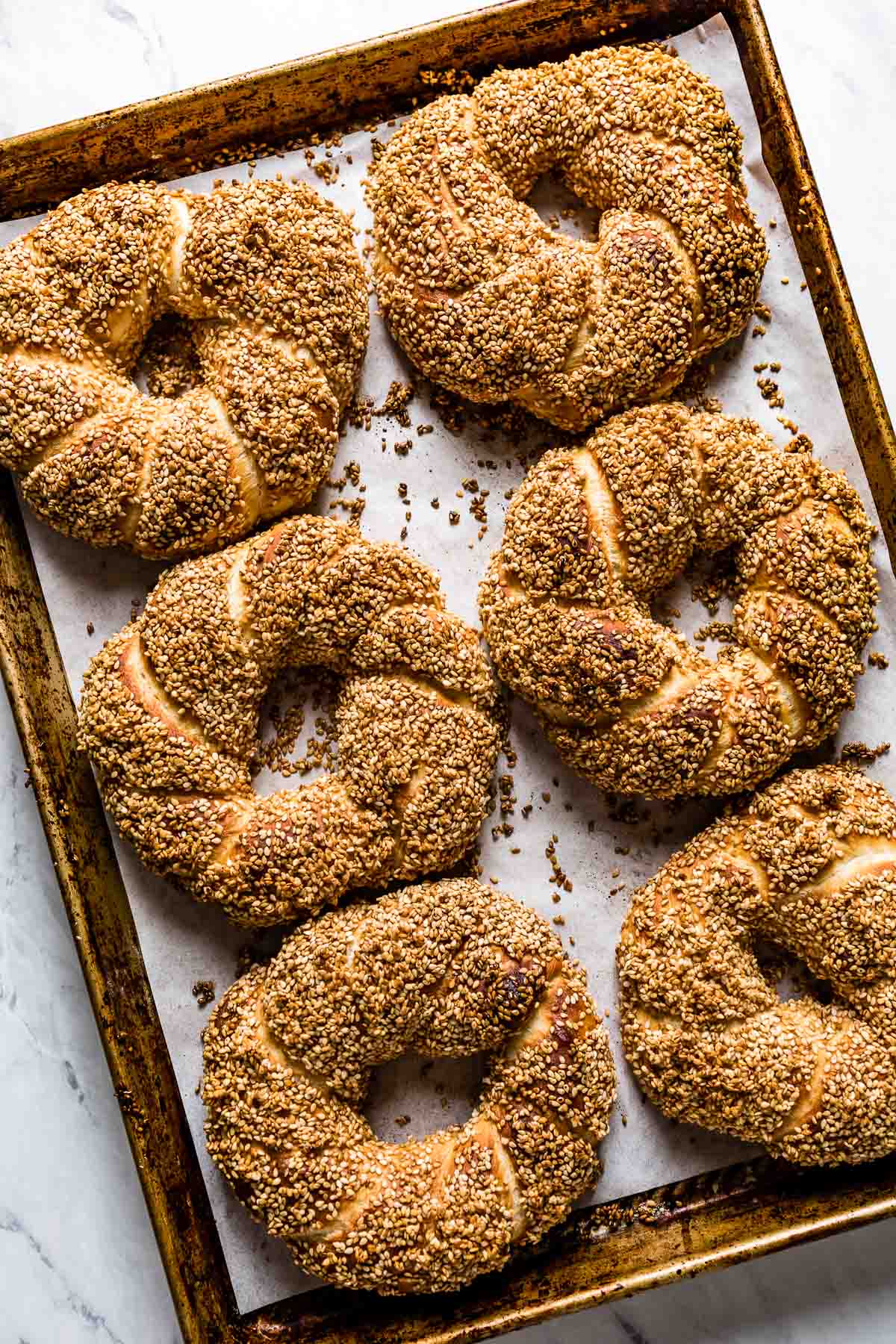
- Bake: Bake both sheets in the oven for 18-20 minutes or until golden brown, making sure to rotate them from top to bottom halfway through the baking process. Let them cool for 5 minutes and serve while still warm.
What To Serve with Turkish Simit Bread?
Traditionally, we serve simit bread for breakfast with feta cheese, olives, sliced tomatoes, cucumbers, Turkish eggs and Turkish tea or Ayran. With that being said, you can serve it with any cheese and even with your favorite jams or preserves.
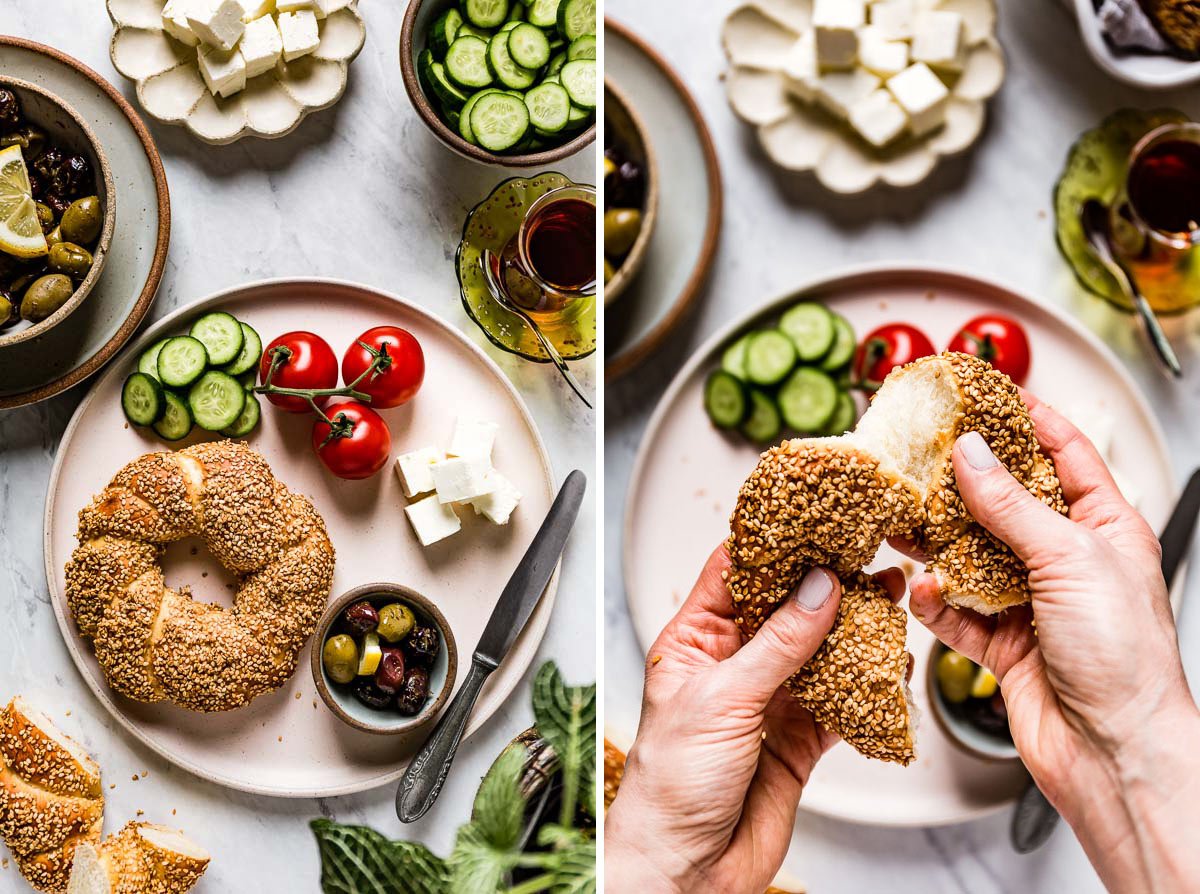
Alternatively, you can make a simit sandwich by slicing it horizontally in half and place cheese, sliced tomatoes, and cucumbers in the middle. You can also do a simit toast by toasting each slice in a toaster.

How To Make Ahead, Store, and Freeze?
The best part of this Turkish bread recipe is that it can be made ahead. So, you can easily make a batch, eat some right away, and freeze the rest for later.
- Make Ahead: Whenever I am serving simit for breakfast, I make the dough a day before (up to 12 hours before), store it in the fridge, and bake it fresh in the morning. To do so, make the recipe until the step right before dipping the braided dough into sesame seeds. Place them on a parchment-lined baking sheet and store them in the fridge. In the morning, remove them from the fridge, let them come to room temperature for about 15-20 minutes, and follow the recipe as written.
- To store leftovers: Bring simit to room temperature, place in a plastic bag, remove the air out as much as you can, and store at room temperature. It should be fresh for up to 2 days. You can toast it for a few minutes before serving.
- To freeze: Repeat the same process but place in the freezer instead. When ready to serve, let it thaw for 10 minutes on the counter, and then heat it in a preheated 300 F degree oven for 10-12 minutes.
Expert Tips:
- The shape doesn’t matter: If this is your first time trying your hand in making this Turkish simit recipe and if your simit strands don’t look like the ones in the pictures, do not worry. I promise that they will look better as they rise, and regardless of their appearance, they will taste great after they are baked. You will get the hang of it after you make it a few times.
- The temperature of the water & milk: For the active dry yeast to get activated, your water must be around 110 F degrees (43 Celsius), and your milk (or heavy cream) is at room temperature. If they are colder or warmer, the yeast might not get activated, and as a result, your simit Turkish bread might fall flat.
- The temperature of your kitchen: As it is with any bread recipe (like I explained in my Challah bread recipe), the temperature of your kitchen (or the time of the year) will affect how much your dough rises. If you are making simit on a hot summer day, it will likely double in size. However, I have made this recipe several times all throughout the year, and it consistently delivered great results.
- The temperature of your oven: Most Turkish simit recipes start with a 400 F degree oven, bake for 20-25 minutes, raise the temperature to 425 to 450 F degrees and then bake a little longer (usually 5-7 minutes). I tested this recipe several times and did not think it was necessary to bake it in two stages. However, I recommend keeping an eye on it after the 18th-minute mark.
- Sesame seeds cook faster than the simit dough: Be careful when you open the oven door at the end of the baking process as some smoke might come out due to sesame seeds cooking faster than the limit.
- Istanbul Simit vs. Street Simit: If you ever visit Turkey, you will see that the simit sold on the street does not have this many sesame seeds because sesame seeds are costly. My mom, who grew up in Istanbul, always made simit with a lot of sesame seeds, similar to how I did here. If you are not a fan, you can adjust the amount and use less.
FAQs:
This Turkish sesame bread is made by mixing flour, yeast, milk (or heavy cream), sesame seeds and molasses.
Compared to American bagels, the Turkish simit is lighter and crustier. Also, there is no boiling done during the process of making simit. Instead, we dip simit dough in a water-molasses mixture and coat it in sesame seeds before baking.
It tastes like a lightly sweetened, savory crusty bread with a very pronounced sesame flavor.
While it is not traditional, you can use honey instead of molasses. However, please be aware that the taste might be slightly different. To do so, use a mixture of 5-6 tablespoons of honey and 4 tablespoons of water instead.
Yes, you can, and I recommend using the dough hook to knead. Also, you might have to adjust the amount of flour by adding more until the dough no longer sticks to the bowl.
Each serving of this recipe is 370 calories.
Other bread recipes you might also like
Other Turkish recipes you might like
- Turkish Lentil Soup
- Yogurt Salad Dressing
- Tabbouleh
- Quinoa Tabbouleh
- Turkish Meatballs Recipe
- Tahini Yogurt Sauce
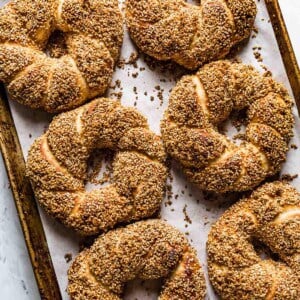
Turkish Simit Recipe (Turkish Bagel)
Ingredients
- 1 cup water, at 110 F degrees (43 Celsius)
- 1 cup whole milk, at room temperature (or heavy cream)
- 2 tablespoons active dry yeast, Or 3 (1/4 oz.) packets
- 2 tablespoons granulated sugar
- 1 large egg, at room temperature
- 2 teaspoons kosher salt
- 3 tablespoons vegetable oil, (Canola, avocado, and grapeseed oil would all work)
- 5 cups all purpose flour, (25 oz.) plus more for when kneading the dough and for the surface
- 3 cups sesame seeds, (12 oz.)
- 7 tablespoons molasses, diluted with 5 tablespoons of water
Instructions
- Activate the yeast: Place water, milk, sugar, and active dry yeast into a measuring cup. Give it a quick whisk, cover it with stretch film, and let it sit on the counter for 10 to 15 minutes or until bubbles form on top.
- Make the dough: Place 5 cups (700 grams) of all-purpose flour, kosher salt, oil, egg, and now-risen yeast-milk mixture in a large mixing bowl. Start mixing by hand until it comes together. Lightly dust the counter with flour and transfer the dough onto the surface. Knead by hand to form a smooth and elastic dough until the dough is not sticking to your fingers. This may take around 15 -17 minutes.
- Let the simit dough rise: Lightly wet a kitchen towel with hot tap water and place it over the dough. Let it sit on the kitchen counter until it doubles in size, 30-45 minutes.
- Toast the sesame seeds: While the dough is rising, place sesame seeds in a large non-stick skillet over medium heat, stirring constantly, and toast until they turn golden brown, 20-25 minutes. Transfer into a large shallow plate to cool.
- Roll The Dough into a Cylinder: Fold the dough from each end onto itself towards the middle, gently pinch, and roll into a cylinder of roughly 20-inches (51 cm.)
- Divide: Using a sharp knife or a pastry scraper, divide the dough into 10 equal pieces, transfer onto a sheet pan (lined with parchment paper), and cover it with a clean kitchen towel (to prevent them from drying as you work on each piece)
- Preheat the oven to 400 F degrees. Line two baking sheets with parchment paper.
- Shape the dough and let it rest: Roll each dough ball into a roughly 40-inch (102 cm) long strand. Fold the string onto itself using your finger to hold it in the middle. Twist the dough in the opposite direction to form a spiral rope. Roll it into a 5-inch diameter ring and gently pinch the end to seal.
- Let it rise: Transfer the now-shaped simits onto the parchment-lined baking sheet. Repeat the same process for the rest of the dough balls. Let them rest until they rise for 30 minutes. How much they rise depends on the temperature of your kitchen.
- Dip: Mix together molasses with water in a large shallow plate. Bring in the sesame seeds. First, dip simit into the molasses mixture (on both sides) and then into the sesame seeds making sure that all sides are fully covered with sesame seeds. Transfer onto a baking sheet and repeat the same process for the rest of the limit.
- Bake in the oven: Bake both sheets in the oven for 18-20 minutes or until golden brown making sure to rotate them from top to bottom halfway through the baking process. Let them cool for 5 minutes and serve while still warm.
Notes
- Yields: This recipe makes 10 of these sesame breads. The nutritional information below is per simit.
- Make Ahead Instructions: Whenever I am serving simit for breakfast, I make the dough a day before (up to 12 hours before), store it in the fridge, and bake it fresh in the morning. To do so, make the recipe until the step right before dipping the braided dough into sesame seeds (until step 10.) Place them on a parchment-lined baking sheet and store them in the fridge. In the morning, remove them from the fridge, let them rest on the counter, and come to room temperature for about 30 minutes, and follow the recipe as written.
- To store leftovers: Bring simit to room temperature, place in a plastic bag, remove the air out as much as you can, and store at room temperature. It should be fresh for up to 2 days. You can toast it for a few minutes before serving.
- To freeze: Repeat the same process but place in the freezer instead. When ready to serve, let it thaw for 10 minutes on the counter, and then heat it in a preheated 300 F degree oven for 10-12 minutes.
- The shape doesn’t matter: If this is your first time trying your hand at making this Turkish simit recipe, and if your simit strands don’t look like the ones in the pictures, do not worry. I promise that they will look better as they rise, and regardless of their appearance, they will taste great after they are baked. You will get the hang of it after you make it a few times.
- The temperature of the water & milk: For the active dry yeast to get activated, your water must be around 110 F degrees (43 Celsius), and your milk (or heavy cream) is at room temperature. If they are colder or warmer, the yeast might not get activated, and as a result, your simit Turkish bread might fall flat.
- Using a standing mixer: The most time-consuming part of this recipe is kneading the dough by hand. If you have a standing mixer, you can knead the dough using the dough hook. To do so, in step 2, instead of mixing everything in a bowl, mix them in the bowl of your mixer. Mix until everything comes together (no more than 7-8 minutes), and it turns into a soft bowl, stopping and scraping the bottom of the bowl a few times. Towards the end, if it is too sticky, you can add a small amount of flour to help it come together.
Nutrition
Nutrition information is automatically calculated, so should only be used as an approximation.
This Turkish Simit recipe post was originally published in April 2014. It has been updated with new photos and minor changes to the originally published recipe in January 2024.
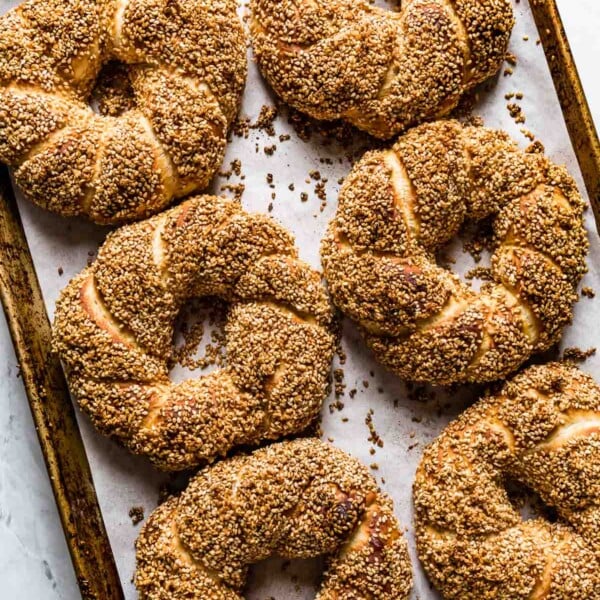


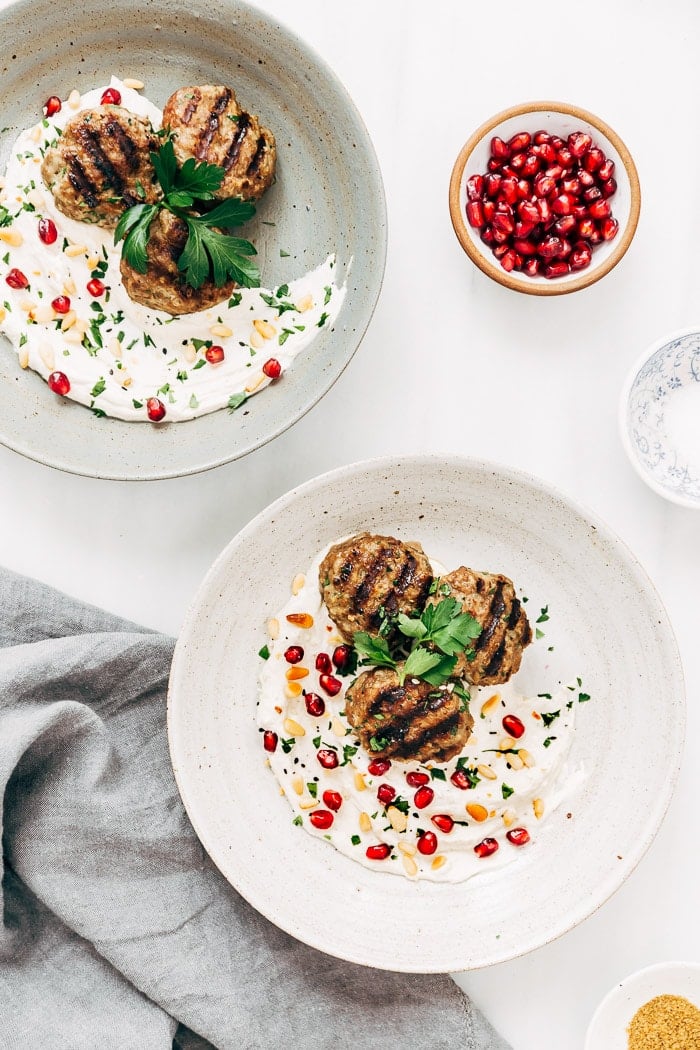











I made these just as written in the recipe. They are delicious and I was surprised by how soft they were inside. I will make these again and hide them from my husband! Thank you for the recipe.
I am happy to hear that this simit recipe worked for you Kim. BTW I totally relate to hiding it from your husband. Mine is the same way 🙂
Thanks for coming by and taking the time to leave a review. Cheers!
Made the simits yesterday and they are delicious!! My husband and I both loved. I don’t think we’ll ever go back to American bagels! Can’t wait to try more of your recipes.
YAY! Thanks Erin. I am thrilled to hear that you enjoyed this recipe.
I hope you enjoy all the other recipes you try. If there are any questions or if you need anything else I am right here to help.
Cheers,
Ice
I missed simit so much and I have been thinking about making simit for the last month. Yesterday my husband and I (both homesick) decided to make this recipe. We found the instructions and photos (btw. they are beautiful) very helpful. We used a mixer in the first 2-3 minutes of kneading but my husband loves kneading so he did the rest. After we made it we had a little taste it was very delicious. Oh! You should have seen my simit lover sons’ faces this morning. They were so excited and absolutely loved it. Simit was still crunchy on the outside and soft on the inside in the morning. We had the best weekday breakfast. Thank you, Aysegul❤️
Awww this warms my heart so much. I am thrilled to hear that you guys enjoyed it. Thanks for taking the time to leave a review and your continued support. Cheers!
Beautiful update, Ayse! I want to make Simit ASAP! These look and sound absolutely delicious. I love how you’ve shaped the dough. It gives the final Simit texture, interest and they’re just stunning!
You are the sweetest my dear friend. I hope you try it sometime.
Cheers!
I lived in Izmir for a year and miss this bread and all of the food so much, thank you for sharing! Do you think I could use a stand mixer instead of doing all the mixing and kneeling by hand?
Hi there,
Izmir is one of my favorite cities in Turkey.
To answer your question.. I have never made simit dough using a stand in mixer but I do not see why not. You might have to add some more flour but I think it would work.
Please let me know if you give it a try. Hope this helps.
Cheers,
Aysegul
I made with my stand up mixer- dough hook, speed 2 for 4-5 mins, scraped down sides of bowl after 2 mins & didn’t need to add more flour.
Thanks for sharing your experience Stephanie.
Merhaba Aysegul. I went to Turkey in November 2018, and absolutely fell in love with simit. Tried another recipe which failed miserably. Just made your recipe, and man, were they good! The dough rose so much in the oven that I am thinking about making at least 15 smaller ones than the 10 the recipe says it yields. May hips might thank me for it.
Merhaba Helen,
Awww it makes me so happy that you liked the recipe. It is one of my favorite Turkish food as well. One that I miss the most, for sure.
Sometimes, if your kitchen is warm, dough might rise more than normal, but I guess that’s not a bad thing, right? 😉
I am so glad to hear that you liked it. Thanks for coming back and leaving a comment.
Cheers!